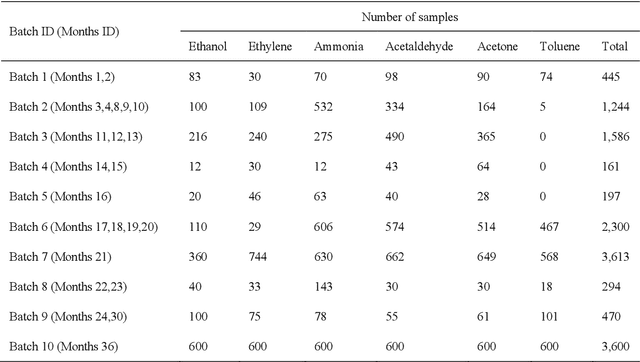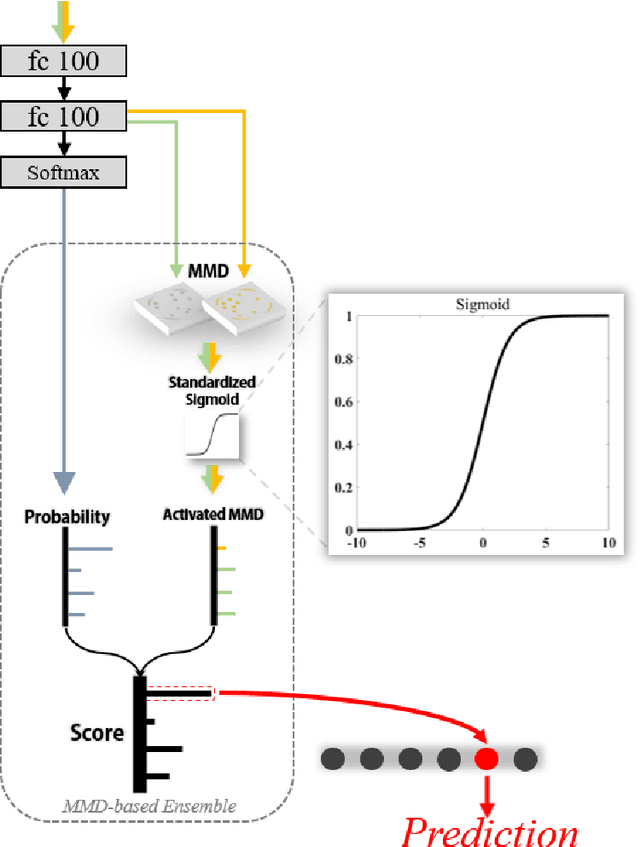Yuelin Zhang
Fast and Distributed Equivariant Graph Neural Networks by Virtual Node Learning
Jun 24, 2025Abstract:Equivariant Graph Neural Networks (GNNs) have achieved remarkable success across diverse scientific applications. However, existing approaches face critical efficiency challenges when scaling to large geometric graphs and suffer significant performance degradation when the input graphs are sparsified for computational tractability. To address these limitations, we introduce FastEGNN and DistEGNN, two novel enhancements to equivariant GNNs for large-scale geometric graphs. FastEGNN employs a key innovation: a small ordered set of virtual nodes that effectively approximates the large unordered graph of real nodes. Specifically, we implement distinct message passing and aggregation mechanisms for different virtual nodes to ensure mutual distinctiveness, and minimize Maximum Mean Discrepancy (MMD) between virtual and real coordinates to achieve global distributedness. This design enables FastEGNN to maintain high accuracy while efficiently processing large-scale sparse graphs. For extremely large-scale geometric graphs, we present DistEGNN, a distributed extension where virtual nodes act as global bridges between subgraphs in different devices, maintaining consistency while dramatically reducing memory and computational overhead. We comprehensively evaluate our models across four challenging domains: N-body systems (100 nodes), protein dynamics (800 nodes), Water-3D (8,000 nodes), and our new Fluid113K benchmark (113,000 nodes). Results demonstrate superior efficiency and performance, establishing new capabilities in large-scale equivariant graph learning. Code is available at https://github.com/GLAD-RUC/DistEGNN.
MrTrack: Register Mamba for Needle Tracking with Rapid Reciprocating Motion during Ultrasound-Guided Aspiration Biopsy
May 14, 2025Abstract:Ultrasound-guided fine needle aspiration (FNA) biopsy is a common minimally invasive diagnostic procedure. However, an aspiration needle tracker addressing rapid reciprocating motion is still missing. MrTrack, an aspiration needle tracker with a mamba-based register mechanism, is proposed. MrTrack leverages a Mamba-based register extractor to sequentially distill global context from each historical search map, storing these temporal cues in a register bank. The Mamba-based register retriever then retrieves temporal prompts from the register bank to provide external cues when current vision features are temporarily unusable due to rapid reciprocating motion and imaging degradation. A self-supervised register diversify loss is proposed to encourage feature diversity and dimension independence within the learned register, mitigating feature collapse. Comprehensive experiments conducted on both motorized and manual aspiration datasets demonstrate that MrTrack not only outperforms state-of-the-art trackers in accuracy and robustness but also achieves superior inference efficiency.
Integrating Extra Modality Helps Segmentor Find Camouflaged Objects Well
Feb 20, 2025Abstract:Camouflaged Object Segmentation (COS) remains a challenging problem due to the subtle visual differences between camouflaged objects and backgrounds. Owing to the exceedingly limited visual cues available from visible spectrum, previous RGB single-modality approaches often struggle to achieve satisfactory results, prompting the exploration of multimodal data to enhance detection accuracy. In this work, we present UniCOS, a novel framework that effectively leverages diverse data modalities to improve segmentation performance. UniCOS comprises two key components: a multimodal segmentor, UniSEG, and a cross-modal knowledge learning module, UniLearner. UniSEG employs a state space fusion mechanism to integrate cross-modal features within a unified state space, enhancing contextual understanding and improving robustness to integration of heterogeneous data. Additionally, it includes a fusion-feedback mechanism that facilitate feature extraction. UniLearner exploits multimodal data unrelated to the COS task to improve the segmentation ability of the COS models by generating pseudo-modal content and cross-modal semantic associations. Extensive experiments demonstrate that UniSEG outperforms existing Multimodal COS (MCOS) segmentors, regardless of whether real or pseudo-multimodal COS data is available. Moreover, in scenarios where multimodal COS data is unavailable but multimodal non-COS data is accessible, UniLearner effectively exploits these data to enhance segmentation performance. Our code will be made publicly available on \href{https://github.com/cnyvfang/UniCOS}{GitHub}.
Theoretical Data-Driven MobilePosenet: Lightweight Neural Network for Accurate Calibration-Free 5-DOF Magnet Localization
Jan 06, 2025



Abstract:Permanent magnet tracking using the external sensor array is crucial for the accurate localization of wireless capsule endoscope robots. Traditional tracking algorithms, based on the magnetic dipole model and Levenberg-Marquardt (LM) algorithm, face challenges related to computational delays and the need for initial position estimation. More recently proposed neural network-based approaches often require extensive hardware calibration and real-world data collection, which are time-consuming and labor-intensive. To address these challenges, we propose MobilePosenet, a lightweight neural network architecture that leverages depthwise separable convolutions to minimize computational cost and a channel attention mechanism to enhance localization accuracy. Besides, the inputs to the network integrate the sensors' coordinate information and random noise, compensating for the discrepancies between the theoretical model and the actual magnetic fields and thus allowing MobilePosenet to be trained entirely on theoretical data. Experimental evaluations conducted in a \(90 \times 90 \times 80\) mm workspace demonstrate that MobilePosenet exhibits excellent 5-DOF localization accuracy ($1.54 \pm 1.03$ mm and $2.24 \pm 1.84^{\circ}$) and inference speed (0.9 ms) against state-of-the-art methods trained on real-world data. Since network training relies solely on theoretical data, MobilePosenet can eliminate the hardware calibration and real-world data collection process, improving the generalizability of this permanent magnet localization method and the potential for rapid adoption in different clinical settings.
MambaXCTrack: Mamba-based Tracker with SSM Cross-correlation and Motion Prompt for Ultrasound Needle Tracking
Nov 13, 2024



Abstract:Ultrasound (US)-guided needle insertion is widely employed in percutaneous interventions. However, providing feedback on the needle tip position via US image presents challenges due to noise, artifacts, and the thin imaging plane of US, which degrades needle features and leads to intermittent tip visibility. In this paper, a Mamba-based US needle tracker MambaXCTrack utilizing structured state space models cross-correlation (SSMX-Corr) and implicit motion prompt is proposed, which is the first application of Mamba in US needle tracking. The SSMX-Corr enhances cross-correlation by long-range modeling and global searching of distant semantic features between template and search maps, benefiting the tracking under noise and artifacts by implicitly learning potential distant semantic cues. By combining with cross-map interleaved scan (CIS), local pixel-wise interaction with positional inductive bias can also be introduced to SSMX-Corr. The implicit low-level motion descriptor is proposed as a non-visual prompt to enhance tracking robustness, addressing the intermittent tip visibility problem. Extensive experiments on a dataset with motorized needle insertion in both phantom and tissue samples demonstrate that the proposed tracker outperforms other state-of-the-art trackers while ablation studies further highlight the effectiveness of each proposed tracking module.
Real-world Image Dehazing with Coherence-based Label Generator and Cooperative Unfolding Network
Jun 12, 2024Abstract:Real-world Image Dehazing (RID) aims to alleviate haze-induced degradation in real-world settings. This task remains challenging due to the complexities in accurately modeling real haze distributions and the scarcity of paired real-world data. To address these challenges, we first introduce a cooperative unfolding network that jointly models atmospheric scattering and image scenes, effectively integrating physical knowledge into deep networks to restore haze-contaminated details. Additionally, we propose the first RID-oriented iterative mean-teacher framework, termed the Coherence-based Label Generator, to generate high-quality pseudo labels for network training. Specifically, we provide an optimal label pool to store the best pseudo-labels during network training, leveraging both global and local coherence to select high-quality candidates and assign weights to prioritize haze-free regions. We verify the effectiveness of our method, with experiments demonstrating that it achieves state-of-the-art performance on RID tasks. Code will be available at \url{https://github.com/cnyvfang/CORUN-Colabator}.
Motion-Guided Dual-Camera Tracker for Low-Cost Skill Evaluation of Gastric Endoscopy
Mar 08, 2024Abstract:Gastric simulators with objective educational feedback have been proven useful for endoscopy training. Existing electronic simulators with feedback are however not commonly adopted due to their high cost. In this work, a motion-guided dual-camera tracker is proposed to provide reliable endoscope tip position feedback at a low cost inside a mechanical simulator for endoscopy skill evaluation, tackling several unique challenges. To address the issue of significant appearance variation of the endoscope tip while keeping dual-camera tracking consistency, the cross-camera mutual template strategy (CMT) is proposed to introduce dynamic transient mutual templates to dual-camera tracking. To alleviate disturbance from large occlusion and distortion by the light source from the endoscope tip, the Mamba-based motion-guided prediction head (MMH) is presented to aggregate visual tracking with historical motion information modeled by the state space model. The proposed tracker was evaluated on datasets captured by low-cost camera pairs during endoscopy procedures performed inside the mechanical simulator. The tracker achieves SOTA performance with robust and consistent tracking on dual cameras. Further downstream evaluation proves that the 3D tip position determined by the proposed tracker enables reliable skill differentiation. The code and dataset will be released upon acceptance.
A Unified Framework for Microscopy Defocus Deblur with Multi-Pyramid Transformer and Contrastive Learning
Mar 05, 2024Abstract:Defocus blur is a persistent problem in microscope imaging that poses harm to pathology interpretation and medical intervention in cell microscopy and microscope surgery. To address this problem, a unified framework including multi-pyramid transformer (MPT) and extended frequency contrastive regularization (EFCR) is proposed to tackle two outstanding challenges in microscopy deblur: longer attention span and feature deficiency. The MPT employs an explicit pyramid structure at each network stage that integrates the cross-scale window attention (CSWA), the intra-scale channel attention (ISCA), and the feature-enhancing feed-forward network (FEFN) to capture long-range cross-scale spatial interaction and global channel context. The EFCR addresses the feature deficiency problem by exploring latent deblur signals from different frequency bands. It also enables deblur knowledge transfer to learn cross-domain information from extra data, improving deblur performance for labeled and unlabeled data. Extensive experiments and downstream task validation show the framework achieves state-of-the-art performance across multiple datasets. Project page: https://github.com/PieceZhang/MPT-CataBlur.
TDACNN: Target-domain-free Domain Adaptation Convolutional Neural Network for Drift Compensation in Gas Sensors
Oct 15, 2021



Abstract:Sensor drift is a long-existing unpredictable problem that deteriorates the performance of gaseous substance recognition, calling for an antidrift domain adaptation algorithm. However, the prerequisite for traditional methods to achieve fine results is to have data from both nondrift distributions (source domain) and drift distributions (target domain) for domain alignment, which is usually unrealistic and unachievable in real-life scenarios. To compensate for this, in this paper, deep learning based on a target-domain-free domain adaptation convolutional neural network (TDACNN) is proposed. The main concept is that CNNs extract not only the domain-specific features of samples but also the domain-invariant features underlying both the source and target domains. Making full use of these various levels of embedding features can lead to comprehensive utilization of different levels of characteristics, thus achieving drift compensation by the extracted intermediate features between two domains. In the TDACNN, a flexible multibranch backbone with a multiclassifier structure is proposed under the guidance of bionics, which utilizes multiple embedding features comprehensively without involving target domain data during training. A classifier ensemble method based on maximum mean discrepancy (MMD) is proposed to evaluate all the classifiers jointly based on the credibility of the pseudolabel. To optimize network training, an additive angular margin softmax loss with parameter dynamic adjustment is utilized. Experiments on two drift datasets under different settings demonstrate the superiority of TDACNN compared with several state-of-the-art methods.
 Add to Chrome
Add to Chrome Add to Firefox
Add to Firefox Add to Edge
Add to Edge